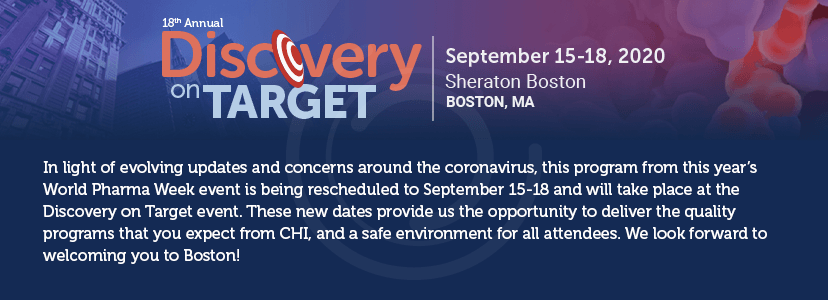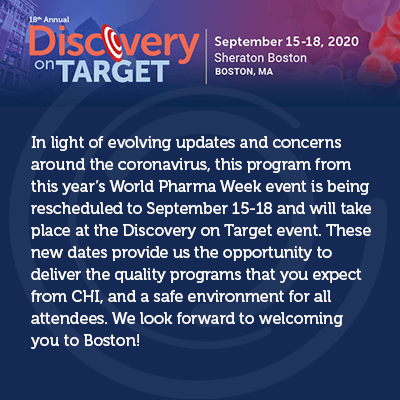

Cambridge Healthtech Institute’s 6th Annual
Disease Modeling
Developing, Validating, Scaling, and Automating Physiologically Relevant Disease Models
June 2-4, 2020
Inadequate representation of the human tissue environment during a preclinical screen can result in inaccurate predictions of a drug candidate’s effects. Thus, investigators are searching for preclinical models that closely resemble original tissue
for predicting clinical outcome. With advances in reprogramming and differentiation technologies, as well as with the recent availability of gene editing approaches, we are finally able to create more complex and phenotypically accurate models that
span all therapeutic areas. At Cambridge Healthtech Institute's 6th Annual Disease Modeling conference, we will discuss the next generation of models, as well as strategies to overcome common bottlenecks, such as standardization, scaling, and workflow
integration.
Final Agenda
Day 1 | Day 2 | Day 3 | Download Brochure
Download Preclinical Program Brochure
SC7: Intro to OOAC and Bioprinting for Disease Modeling - Detailed Agenda
*Separate registration required.
Tuesday, June 2
In the past decade, a lot of momentum has been gaining for three-dimensional (3D) cell culture; proponents state that this is more physiologically relevant, but admit that we still need to discuss standardization, validity, scalability and more. Join
us on Day 1 of the Disease Modeling conference at World Pharma Week as we discuss innovations, specific-use cases of 3D-oids (organoids, spheroids or tumoroids), and applications for drug discovery and development.
10:00 am Main Conference Registration Open
11:15 Chairperson’s Remarks
Virneliz Fernandez Vega, Scientific Associate, Molecular Medicine, Scripps Research
11:20 Combining 3D Models and Functional Genomics in Preclinical Drug Development
 Alejandro Amador, PhD, Scientific Leader, Platform Biology Automation, GSk
Alejandro Amador, PhD, Scientific Leader, Platform Biology Automation, GSk
The current preclinical oncology drug discovery paradigm involves lengthy and costly optimization/lead discovery campaigns, often using cellular or in vivo tumor models with weak translational relevance that don’t
closely resemble human solid tumors. I will highlight opportunities/challenges in implementing 3D solid tumor models. I will outline key components that should be considered when developing, validating, scaling, and automating 3D solid tumor models
that are more physiologically relevant.
11:40 Adult Stem Cell Organoids: A Patient in the Lab
 Robert Vries, PhD,
CEO, Hubrecht Organoid Technology (HUB)
Robert Vries, PhD,
CEO, Hubrecht Organoid Technology (HUB)
Key to the development of the HUB Organoid Technology was the discovery of adult stem cells by Hans Clevers. Provided with the appropriate growth factors, the adult stem cells form a polarized epithelium in which stem cells and their differentiated offspring
maintain their natural hierarchy and function. In addition, the organoids are genetically stable during prolonged culture. Subsequently, we developed Organoid technology for most other epithelia. High-establishment efficiency means that we can use
the Organoid Technology to generate disease models from virtually all patients.
12:00 pm Understanding Donor-to-Donor Variability in Healthy Human Gut-Derived Organoids
 Linda Lieberman, PhD, Principal Scientist, Merck Exploratory Science Center
Linda Lieberman, PhD, Principal Scientist, Merck Exploratory Science Center
Primary organotypic cultures need to be robust and reproducible with limited donor-to-donor variability to advance discovery research toward complex functional tissue biology, yet donor-to-donor variability has not been characterized systematically for
many human organoid systems. We established intestinal organoid cultures from adult stem cells of healthy donors and characterized inter- and intra-culture variability. We found that differentiation patterns were consistent among cultures and passages,
producing all expected intestinal cell types.
12:20 3D cultures Reveal YAP-independent Mechanotransduction Drives Breast Cancer Progression
 Joanna Lee,
PhD, Scientist, Genentech
Joanna Lee,
PhD, Scientist, Genentech
The transcriptional regulator YAP is considered a universal mechanotransducer, based largely on 2D culture studies. We show a lack of YAP activity in cells in 3D culture and in vivo, which is associated with drastic changes in nuclear morphology
relative to cells in 2D culture. This work highlights the context-dependent role of YAP in mechanotransduction, and establishes that YAP does not mediate mechanotransduction in breast cancer.
12:55 Transition to Lunch
1:00 Luncheon Presentation (Sponsorship Opportunity Available) or Enjoy Lunch on Your Own
1:30 Session Break
2:00 Chairperson’s Remarks
Virneliz Fernandez Vega, Scientific Associate, Molecular Medicine, Scripps Research
2:05 3D Enteroid-Derived “Gut-in-a-Dish” Model for Developing Personalized Therapies for Chronic Inflammatory Diseases
 Soumita Das,
PhD, Associate Professor, Department of Pathology, Chief Scientific Director, HUMANOID Center of Research Excellence (CoRE), University of California, San Diego
Soumita Das,
PhD, Associate Professor, Department of Pathology, Chief Scientific Director, HUMANOID Center of Research Excellence (CoRE), University of California, San Diego
We have developed a Gut-in-a-dish model from 3D organoids isolated from the intestinal specimens of healthy and diseased patients. This model consisting of epithelial cells, immune cells, and microbes could be utilized to investigate mechanisms for gastrointestinal
inflammatory diseases, both oncogenic and non-oncogenic. A semi-HTP format of the model can be useful for the identification of new diagnostic and therapeutic targets, personalization of therapies through Phase “0” human trials, and much
more.
2:35 3D Models of Brain Cancer for Precision Medicine Therapeutic Profiling
 Virneliz Fernandez Vega, Scientific Associate, Molecular Medicine, Scripps Research
Virneliz Fernandez Vega, Scientific Associate, Molecular Medicine, Scripps Research
Our goal is to develop and validate a precision medicine therapeutic profiling technology by implementing rapid, cost-effective, physiologically relevant, functional 3D models of brain cancer for phenotypic evaluation of anti-cancer drugs. This combined
with molecular pathology has been implemented into clinically pertinent information, which will improve the quality and speed of a physician’s decision-making for drug selection in treating cancer in a patient-specific manner.
3:05 Development of a Miniaturized 3D Organoid Culture Platform for Ultra-High-Throughput Screening (uHTS)
 Yuhong Du, PhD,
Associate Professor, Department of Pharmacology and Chemical Biology, Associate Director, Emory Chemical Biology Discovery Center (ECBDC), Emory University School of Medicine
Yuhong Du, PhD,
Associate Professor, Department of Pharmacology and Chemical Biology, Associate Director, Emory Chemical Biology Discovery Center (ECBDC), Emory University School of Medicine
“Organoids” with an extracellular matrix to support 3D architecture offer a new approach for drug discovery. However, it has been challenging for high-throughput screening (HTS)-based drug discovery due to technical difficulties. We have developed
such a 3D organoid culture with an extracellular matrix in high-density, 1536-well plate for ultra-HTS (uHTS), and validated its application for large-scale primary compound screening. Our miniaturized platform provides an enabling technology to accelerate
organoid-based drug discovery.
3:35 Methods and Media for the Differentiation of Human Intestinal Organoids and Organoid-Derived Monolayers
 Martin
Stahl, Scientist, R&D Intestinal, Stemcell Technologies Inc.
Martin
Stahl, Scientist, R&D Intestinal, Stemcell Technologies Inc.
Organoid cultures have redefined the limits of biological data that can be obtained in vitro. Learn about how IntestiCult™ Organoid Differentiation Medium drives the differentiation of organoids and organoid-derived
monolayer cultures into a more functional, differentiated epithelium that better recapitulates the cellular composition and function of the human intestinal epithelium.
3:50 Sponsored Presentation (Opportunity Available)
4:05 Networking Refreshment Break and Transition to Keynote
4:25 - 6:05 Driving Entrepreneurial Innovation to Accelerate Therapeutic Discoveries
The life sciences community has an unprecedented scientific arsenal to discovery, develop and implement treatments, cures and preventions that enhance human healthcare.
 Moderator: Nadeem
Sarwar, President, Eisai Center for Genetics Guided Dementia Discovery (G2D2), Eisai Inc.
Moderator: Nadeem
Sarwar, President, Eisai Center for Genetics Guided Dementia Discovery (G2D2), Eisai Inc.
Panelists: Anthony Philippakis, Chief Data Officer, Broad Institute; Venture Partner, GV
Barbara Sosnowski, Vice President and Global Head, Emerging Science & Innovation Leads, WWRDM, Pfizer
John Hallinan, Chief Business Officer, Massachusetts Biotechnology Council
6:05 Welcome Reception in the Exhibit Hall with Poster Viewing
7:10 Close of Day
Day 1 | Day 2 | Day 3 | Download Brochure
Wednesday, June 3
With advances in reprogramming and differentiation technologies, as well as with the recent availability of gene editing approaches, we are finally able to create more complex and phenotypically accurate cellular models based on pluripotent cell technology.
This opens new and exciting opportunities for pluripotent stem cell utilization in early discovery, preclinical, and translational research. Day 2 of the Disease Modeling conference at World Pharma Week is designed to bring together experts and bench
scientists working with induced pluripotent cells, end-users of their services, and researchers working on finding cures for specific diseases and disorders.
7:30 am Registration Open and Morning Coffee
8:10 Chairperson’s Remarks
Stefan Braam, PhD, CEO, Ncardia
8:15 FEATURED PRESENTATION: Generation, Validation & Application of iPSC Models in Early Discovery
 Lisa Mohamet,
PhD, Scientific Leader, Drug Design & Selection, GSK
Lisa Mohamet,
PhD, Scientific Leader, Drug Design & Selection, GSK
This presentation will focus on the use of iPSC-derived platforms, complex in vitro models to improve disease relevance in phenotypic screening, and target engagement.
8:45 Using “Brains-in-a-Dish” to Investigate Developmental Features of Huntington Disease
 Mahmoud Pouladi, PhD, Principal Investigator, Agency for Science, Technology and Research (A*STAR) and National University of Singapore (NUS)
Mahmoud Pouladi, PhD, Principal Investigator, Agency for Science, Technology and Research (A*STAR) and National University of Singapore (NUS)
Cerebral organoids grown from human embryonic and pluripotent stem cells can be used to perform detailed studies on brain development and to understand cellular mechanisms underlying Huntington’s disease. Details of these findings and other possible
applications will be discussed.
9:15 Development of Patient-Derived iPSC Models and Phenotypic Assays for Early Drug Discovery in Neuroscience
 Yoshiyuki Tsujihata, PhD, Director, Phenotypic Reverse Translation Lab, Neuroscience Drug Discovery Unit, Takeda Pharmaceutical Company Limited
Yoshiyuki Tsujihata, PhD, Director, Phenotypic Reverse Translation Lab, Neuroscience Drug Discovery Unit, Takeda Pharmaceutical Company Limited
Phenotypic assay/screening, with patient iPSC-derived models and quantitative image analysis, is an attractive strategy to develop innovative drugs in neurological disorders. Our strategy is to create simple and complex assay systems comprised of iPSC-derived
neurons and glial cells and quantitatively capture pathological events, such as synapse plasticity and mitochondrial dysfunction. Those are being developed with a robustness that not only supports initial screening, but also downstream pharmacological
and mechanistic evaluations.
9:45 Sponsored Presentation (Opportunity Available)
10:00 Presentation to be Announced
10:15 Coffee Break in the Exhibit Hall with Poster Viewing
11:00 Reconstruction of the Human Blood-Brain Barrier in vitro Reveals the Pathogenic Mechanisms of APOE4 in Cerebral Amyloid Angiopathy
 Joel
Blanchard, PhD, Postdoctoral Fellow, Picower Institute for Learning and Memory, MIT
Joel
Blanchard, PhD, Postdoctoral Fellow, Picower Institute for Learning and Memory, MIT
Alzheimer’s disease leads to amyloid deposits along cerebral vasculature which impair the function of the blood-brain barrier (BBB) and accelerate cognitive degeneration. APOE4 is the strongest risk factor for cerebrovascular amyloid pathology (CAA)
and Alzheimer’s disease (AD); however, the underlying pathogenic mechanisms are unknown. We developed an in vitro model of the human BBB that revealed the mechanisms through which APOE4 predisposes amyloid deposition,
and uncovered new therapeutic opportunities for CAA and AD.
11:30 3D Alzheimer’s Disease (AD) Model for Studying the Blood-Brain Barrier Dysfunctions in Ad
 Yoojin Shin,
PhD, Postdoctoral Fellow, Mechanical Engineering, Roger Kamm’s Lab, MIT
Yoojin Shin,
PhD, Postdoctoral Fellow, Mechanical Engineering, Roger Kamm’s Lab, MIT
We have developed a physiologically relevant three-dimensional (3D) Alzheimer’s disease (AD) model with a neurovascular unit (blood-brain barrier, BBB) including human neurons, astrocytes, pericytes, and brain endothelial cells in a microfluidic
system. Using this model, we have investigated BBB dysfunction, such as the increase in permeability and abnormal angiogenesis in AD, and explored whether Aβ and/or toxic molecules disrupt normal BBB function.
 12:00 pm Rediscovering the Potential of 3D Cell Culture: From Development to Disease Modeling
12:00 pm Rediscovering the Potential of 3D Cell Culture: From Development to Disease Modeling
Christopher Suarez, PhD, Field Applications Manager, Corning Life Sciences, Corning Incorporated
Recently, there is renewed focus on 3D cell culture, as 2D culture is insufficient to support complex cellular behaviors. Three-dimensional culture more accurately recapitulates complex tissues making this better suited for studying development, disease
and drug response. This seminar will highlight scaffold and scaffold-free approaches for generating robust 3D models.
12:15 Sponsored Presentation (Opportunity Available)
12:30 Transition to Lunch
12:35 LUNCHEON PRESENTATION: Structural Maturation in the Development of hiPSC-Cardiomyocyte Models for Preclinical Safety, Efficacy, and Discovery
 Nicholas Geisse, PhD, CSO, NanoSurface Biomedical
Nicholas Geisse, PhD, CSO, NanoSurface Biomedical
HiPSC-CM maturation is sensitive to structural cues from the extracellular matrix (ECM). Failure to reproduce these signals in vitro can hamper experimental reproducibility and fidelity. Engineering approaches to address
this gap typically trade off complexity with throughput, making them difficult to deploy in the modern development paradigm. NanoSurface technology leverages scalable engineering approaches in a cell-, assay-, and instrument-agnostic manner. It can
be employed non-disruptively in nearly any workflow to enhance an assay’s predictive power.
1:05 Session Break
1:45 - 3:15
Lgr5 Stem Cell-Based Organoids in Human Disease
 Hans Clevers, MD, PhD,
Principal Investigator of Hubrecht Institute and Princess Máxima Center, CSO of HUB Organoids Technology
Hans Clevers, MD, PhD,
Principal Investigator of Hubrecht Institute and Princess Máxima Center, CSO of HUB Organoids Technology
Organoid technology opens a range of applications in fields such as physiology, study of disease, drug development and personalized medicine. Human organoids represent excellent disease models, be it infectious, hereditary or malignant Eventually,
cultured mini-organs may be used to replace transplant organs from donors. I will describe how we originally created ‘mini-guts’ via 3D culture systems of stem cells of the small intestine and colon, and then expanded the technology to
virtually all human organs.
Systematically Drugging Ras
 Stephen Fesik, PhD,
Professor of Biochemistry, Pharmacology, and Chemistry, Orrin H. Ingram II Chair in Cancer Research, Vanderbilt University School of Medicine
Stephen Fesik, PhD,
Professor of Biochemistry, Pharmacology, and Chemistry, Orrin H. Ingram II Chair in Cancer Research, Vanderbilt University School of Medicine
K-Ras is a small GTPase that is mutated in pancreatic (90%), colon (50%), and lung (30%) carcinomas. Downregulation of activated Ras reverses the transformed phenotype of cells and results in the dramatic regression of tumors in murine xenograft models.
Thus, K-Ras inhibition represents an attractive therapeutic strategy for many cancers. In this presentation, I will discuss our efforts to directly target Ras at two sites and target SOS, a molecular partner of Ras, with activators and inhibitors.
3:15 Refreshment Break in the Exhibit Hall with Poster Viewing
4:00 Chairperson’s Remarks
Chairperson to be Announced, Maxwell Biosystems
4:05 HiPSC-Based Disease Modeling and Taking iPSC Derivatives to the Clinic
 Dhruv
Sareen, PhD, Executive Director, Cedars-Sinai Biomanufacturing Center, Director, iPSC Core and Assistant Professor, Departments of Biomedical Sciences and BOG Regenerative Medicine Institute, Cedars-Sinai
Dhruv
Sareen, PhD, Executive Director, Cedars-Sinai Biomanufacturing Center, Director, iPSC Core and Assistant Professor, Departments of Biomedical Sciences and BOG Regenerative Medicine Institute, Cedars-Sinai
This presentation will discuss modeling neurological, metabolic, and pancreatic diseases using iPSCs in different formats in vitro, including Tissue-Chips. Then it will discuss a pathway for taking iPSC-derived cells
to the clinic describing processes used for cGMP manufacturing, including Cedars-Sinai’s new biomanufacturing center.
4:35 Neuromuscular Junction-on-a-Chip Model
 Graham
Marsh, PhD, Scientist II, Biogen
Graham
Marsh, PhD, Scientist II, Biogen
Modeling the complex physiology of the human NMJ is essential to building our understanding of the underlying biology of diseases. We have developed a 3D co-culture model of the NMJ, including iPSC-derived motor neurons and skeletal muscle cells with
physiological and translatable readouts that recapitulate a patient phenotype in vitro.
5:05 Find Your Table, Meet Your Moderator
5:10 Roundtable Breakout Discussions - View Details
TABLE: Organoids – Is It a Fad or an Enduring Technology?
Moderator: Angela Zhang, PhD, Product Manager, Epithelial Cell Biology, Research & Development, Stemcell Technologies
TABLE: Developing Organs-on-a-Chip/Microphysiological Systems for Drug Discovery
Moderator to be Announced
5:45 Reception in the Exhibit Hall with Poster Viewing
6:45 Close of Day
Day 1 | Day 2 | Day 3 | Download Brochure
Thursday, June 4
Day 3 of the Disease Modeling conference at World Pharma Week will focus on cellular and tissue engineering and will explore a variety of approaches, including microfluidic engineering methods like organ-on-a-chip, as well as bioprinting. This
day will also discuss the applications of such approaches for disease modeling and drug testing.
8:00 am Registration Open and Morning Coffee
8:30 - 9:40 Applications of Artificial Intelligence in Drug Discovery – Separating Hype from Utility
 Patrick Walters, PhD, Senior Vice President, Computation, Relay Therapeutics
Patrick Walters, PhD, Senior Vice President, Computation, Relay Therapeutics
Over the last few years, there has been tremendous interest in the application of artificial intelligence and machine learning in drug discovery. Ultimately, the success of any predictive model comes down to three factors: data, representation,
and algorithms. This presentation will provide an overview of these factors and how they are critical to the successful implementation and deployment of AI methods.
9:40 Coffee Break in the Exhibit Hall with Poster Viewing
10:25 Chairperson’s Remarks
Roger Kamm, PhD, Cecil and Ida Green Distinguished Professor of Mechanical and Biological Engineering, Departments of Mechanical Engineering and Biological Engineering, Massachusetts Institute of Technology
10:30 KEYNOTE PRESENTATION: PhysioMimetics: Integration of Systems Biology with Organs-on-Chips for Drug Development
 Linda Griffith, PhD, School of Engineering Professor of Teaching Innovation, Biological Engineering, and Mechanical Engineering, Massachusetts Institute of Technology
Linda Griffith, PhD, School of Engineering Professor of Teaching Innovation, Biological Engineering, and Mechanical Engineering, Massachusetts Institute of Technology
11:00 IQ MPS Consortium Update
 Szczepan Baran, Head, Emerging Technologies, LAS, SO, Novartis
Szczepan Baran, Head, Emerging Technologies, LAS, SO, Novartis
The International Consortium for Innovation and Quality in Pharmaceutical Development (IQ) is a technically-focused organization of pharmaceutical and biotechnology companies with a mission of advancing science and technology to augment the capability
of member companies to develop transformational solutions that benefit patients, regulators, and the broader R&D community.
11:30 Biofabrication of 3D Tissues for Disease Modeling and Drug Screening
 Marc
Ferrer, PhD, Leader, Biomolecular Screening and Probe Development, Division of Pre-Clinical Innovation, National Center for Advancing Translational Sciences, National Institutes of Health (NIH)
Marc
Ferrer, PhD, Leader, Biomolecular Screening and Probe Development, Division of Pre-Clinical Innovation, National Center for Advancing Translational Sciences, National Institutes of Health (NIH)
The NCATS 3D Tissue Bioprinting Laboratory is using biofabrication techniques together with quantitative assay technologies to produce architecturally and physiologically validated normal and diseased 3D tissue models in multi-well plate format
to create an in-tissue assay platform for drug discovery and development that will be more clinically predicative than current in vitro cellular models. The presentation will describe the approach used at
NCATS to create a portfolio of biofabricated 3D tissue models of the retina, skin, ometum and brain, as in tissue assay platforms for disease modeling, including age-related macular degeneration, atopic dermatitis and several cancers, and
for pharmacological testing of toxicity and efficacy effects.
12:00 pm Sponsored Presentation (Opportunity Available)
12:30 Transition to Lunch
12:35 Luncheon Presentation (Sponsorship Opportunity Available) or Enjoy Lunch on Your Own
1:05 Dessert and Coffee Break in the Exhibit Hall with Poster Viewing
2:00 Chairperson’s Remarks
Madhu Lal-Nag, PhD, Program Lead, Research Governance Council, Office of Translational Sciences, Center for Drug Evaluation & Research, U.S. Food and Drug Administration
2:05 Emerging Microphysiological Systems for Drug Safety Testing: A Regulatory Perspective
 Madhu Lal-Nag,
PhD, Program Lead, Research Governance Council, Office of Translational Sciences, Center for Drug Evaluation & Research, U.S. Food and Drug Administration
Madhu Lal-Nag,
PhD, Program Lead, Research Governance Council, Office of Translational Sciences, Center for Drug Evaluation & Research, U.S. Food and Drug Administration
There is a great need to understand the synergy between the areas of translational and regulatory science research as they pertain to microphysiological systems and their application in evaluating safety and efficacy for therapeutic indications
for different disease areas. My presentation will focus on identifying these areas of synergy and focus on the development of microphysiological systems that are a best fit for different applications.
2:35 Microphysiological Systems: Tissues on Chip for Safety, Toxicity, and Efficacy Tools in Precision Medicine
 Danilo Tagle, PhD, Associate Director for Special Initiatives, National Center for Advancing Translational Sciences, National Institutes of Health
Danilo Tagle, PhD, Associate Director for Special Initiatives, National Center for Advancing Translational Sciences, National Institutes of Health
Microphysiological systems are bioengineered in vitro tools that mimic the 3D structure and function of human organ systems and have been developed to improve the predictive assessment of the safety and efficacy
of promising therapeutics. The use of human-derived cells and tissues have increased the utility of tissue chips towards modeling diseases and for clinical trials on chips to inform human trial design. This presentation will focus on the latest
advances in this promising technology.
3:05 Of Microtissues and Men: Applications of Advanced in vitro Systems in Toxicology
 Matthew Wagoner, PhD, Director, Investigative Toxicology, Takeda Pharmaceutical
Matthew Wagoner, PhD, Director, Investigative Toxicology, Takeda Pharmaceutical
Advanced in vitro cell culture systems are transforming the way we design safer medicines. Here we share case studies of how neural, hepatic, and intestinal organoids are allowing us to more effectively detect and de-risk toxicity, while reducing
a reliance on animal models.
3:35 Close of Conference
Day 1 | Day 2 | Day 3 | Download Brochure